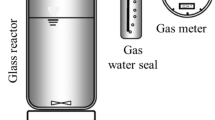Abstract
The study conducted basic component analyses including three component analyses, elementary analysis and heavy metal content and BMP test according to the mixing ratio for food waste leachate and wastewater treatment sludge(from brewery, dairy factory, bread factory, sewage sludge), and calculated biogas production speed using mathematical models. According to the elementary analysis of organic wastes, the C/N ratio, a major condition for anaerobic digestion, is 5.40–9.23, except for food waste leachate (FWL). Defined by Tchobanoglous’ mathematical biogas prediction model, methane gas and biogas productions increased, depending on the mixing rate of FWL. Furthermore, anaerobic digestion of both wastewater sludge and food waste leachate based on the correct mixing ratio, increases methane gas productions compared to digesting wastewater sludge alone. In other words, co-anaerobic digestion is more likely to realize biogasification than single anaerobic digestion. We mixed food waste leachate and wastewater treatment sludge by proportion of 1:9, 3:7, and 5:5, respectively. It turns out that they produced 118, 175, 223 CH4 mL/g VS with the dairy factory, 176, 233, 263 CH4mL/g VS with the brewery, 268, 300, 314 CH4 mL/g VS with the bread factory and 233, 298, 344 CH4-mL/g VS with the sewage sludge of methane gas. The result proposes that as the mixing rate of food waste leachate rises, the methane gas production increases as well. In the case of co-digestion of wastewater treatment sludge and food waste leachate based on the mixing ratio, more methane gas is produced compared to single digestion of wastewater treatment sludge. Modified Gompertz and exponential models describe the BMP test results that show how methane gas is produced from organic waste. According to the test, the higher the mixing rate of food waste leachate is, the higher the methane gas production is. The mixing ratio of food waste leachate which produces the largest volume of methane gas is 1:9 for the dairy and bread facilities and 3:7 for brewery and sewage sludge. Modified Gompertz and exponential models describe the test results very well. The correlation values (R 2) that show how close the results of model prediction and experiment are 0.920–0.996.



Similar content being viewed by others
References
Danny Harvey LD (1993) A guide to global warming potentials (GWPs). Energy Policy 21(1):24–34
Owen WF, Stuckey DC, Healy JB, Young LY, McCarty PL (1979) Bioassay for Monitoring biochemical methane potential and anaerobic toxity. Water Resour 13: 485–492
Tchobanoglous G, Theisen H, Vigil S (1993) Integrated solid waste management engineering principles and management issues. McGraw-Hill Publishing Company, New York USA
Buswell AM, Mueller HF (1952) Mechanism of methane fermentation. Ind Eng Chem 44(3):550–552
Gossett JM (1975) Heat treatment of refuse for increasing anaerobic biodegradability. Civil Engineering Technical Report, 198. Stanford University, Stanford
Chynoweth DP, Turick CE, Owen JM, Jerger DE, Peck MW (1993) Biochemical methane potential of biomass and waste feedstocks. Biomass Bioenergy 5(1):95–111
Weiland P (2010) Biogas production: current state and perspectives. Appl Microbiol Biotechnol 85(4):849–860
Shelton DR, Tiedje JM (1984) General method for determining anaerobic biodegradation potential. Appl Environ Microbiol 47(4):850–857
Parkin GF, Owen WF (1986) Fundamentals of anaerobic digestion of wastewater sludge. J Environ Eng 112:867–920
McCarty PL (1964) Anaerobic waste treatment fundamentals, I. Chemistry and microbiology II. Environmental requirements and control III. Toxic materials and their control IV. Process design. Public Works 95:9–12
McCarty PL, McKinney RE (1961) Volatile acid toxicity in anaerobic digestion. JWPCF 33(3):223–232
WPCF (1987) Anaerobic Sludge Digestion, Manual of Practice 16, 2nd Edition
Cho JK, Park SC, Chang HN (1995) Biochemical methane potential and solid state anaerobic digestion of Korea food waste. Bioresour Technol 52:245–253
Rodrigo AL, Largus TA, Norman RS (2011) Biochemical methane potential and biodegradability of complex organic substrates. Bioresour Technol 102:2255–2264
EI-mashad HM, Zhang R (2010) Biogas production from co-digestion of dairy manure and food waste. Bioresour Technol 101:4021–4028
Bilgili MS, Ahmet D, Gamze V (2009) Evaluation and modeling of biochemical methane potential(BMP) of landfilled solid waste: a pilot scale study. Bioresour Technol 100:4976–4980
Lee D, Lee S, Bae J, Kang J, Kim K, Rhee S, Park J, Cho J, Chung J, Seo D (2015) Effect of volatile fatty acid concentration on anaerobic degradation rate from field anaerobic digestion facilities treating food waste leachate in South Korea. J Chem. doi:10.1155/2015/640717
Kim S, Ju H (2012) Feasibility of co-digestion of sewage sludge, swine waste and food waste leachate. J Korea 20(1):61–70
Author information
Authors and Affiliations
Corresponding author
Rights and permissions
About this article
Cite this article
Yoon, Y., Lee, S., Kim, K. et al. Study of anaerobic co-digestion on wastewater treatment sludge and food waste leachate using BMP test. J Mater Cycles Waste Manag 20, 283–292 (2018). https://doi.org/10.1007/s10163-017-0581-9
Received:
Accepted:
Published:
Issue Date:
DOI: https://doi.org/10.1007/s10163-017-0581-9




